10g (9.0.4)
Part Number B10404-01
Home |
Solution Area |
Contents |
Index |
| Oracle Application Server InterConnect User's Guide 10g (9.0.4) Part Number B10404-01 |
|
This chapter discusses using Oracle Workflow to apply business logic to an integration. Topics include:
Oracle Workflow is integrated with OracleAS InterConnect and is used for business process collaborations across two or more applications. A business process collaboration is defined as the conversation between two or more applications in the context of a business process.
OracleAS InterConnect leverages the robust design time and runtime Oracle Workflow business process definition and execution support to make business processes explicit and manageable.
The following are some of the common business problems that can be solved using Oracle Workflow.
If there is a problem in a conversation between two or more applications, the errors arising from this problem can be centrally managed and appropriate remedial actions can be defined. For example, it may be required to keep the data of an order entry system synchronize with a backend ERP system. Consider that a new purchase order is created in the order entry system but the ERP system is down at the time the purchase order is created. At a later time, the ERP system comes back up and an attempt is made to create a corresponding new purchase order through messaging using OracleAS InterConnect. This attempt fails. To deal with this scenario, the integrator can utilize Oracle Workflow to send a compensating message to the order entry system to undo the creation of the purchase order and notify the user who created the order.
In the example above, OracleAS InterConnect and Oracle Workflow can be used to model the following for every purchase order that is over $50,000:
Fan-in and fan-out of messages can be effectively modeled using OracleAS InterConnect and Oracle Workflow. Fan-in messages involve combining two or more messages into one. Fan-out messages involve splitting one message into two or more.
For an example of fan-in messaging, consider the following. A global organization has a centralized Human Resources Enterprise Resource Planning (ERP) application in the United States. Each country has one or more local systems that capture local employee information. If a new employee joins the Japanese branch of this organization, data is entered into a local human resources application and a local Benefits application. Each entry launches a message for adding this information to the centralized system. However, the centralized system needs data from both systems combined and will only commit the data if it was entered successfully in both of the local systems connecting to OracleAS InterConnect. Using Oracle Workflow, this process can be modeled so that OracleAS InterConnect routes messages from both local systems to Oracle Workflow, Oracle Workflow waits until it receives both messages, combines the data, and launches a single message to be delivered by OracleAS InterConnect to the centralized human resources system.
OracleAS InterConnect provides extensive support for stateless routing through event-based and content-based routing features. Using Oracle Workflow, stateful routing can be accomplished. In other words, the decision to route can be based on more than the event or the content of the message.
Combining all of the examples, an internal (organization focused) or external (customer/partner focused) service can be built through a well-defined set of business processes involving communication between two or more applications. For example, a brick-and-mortar retail company wants to provide an on-line procurement service to their customers. Behind the user interface are several business processes controlling communication across several internal applications to deliver a robust, performant service to the customer.
The following describes how OracleAS InterConnect and Oracle Workflow are integrated.
During design time, business process and event definitions in iStudio can be deployed to Oracle Workflow. Consequently, Oracle Workflow tools can be launched from within iStudio to graphically create process diagrams in the context of enterprise integration through OracleAS InterConnect.
Using iStudio, the following tools can be launched:
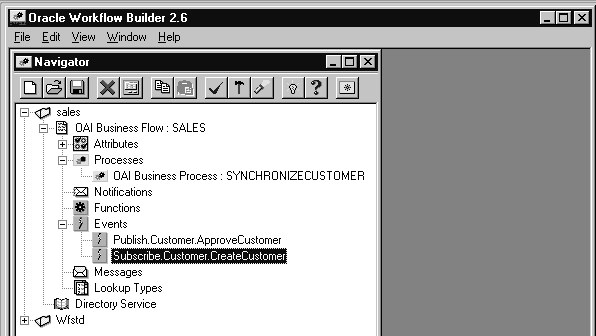
For more information on the Business Event System, see Oracle Workflow Administrator's Guide.
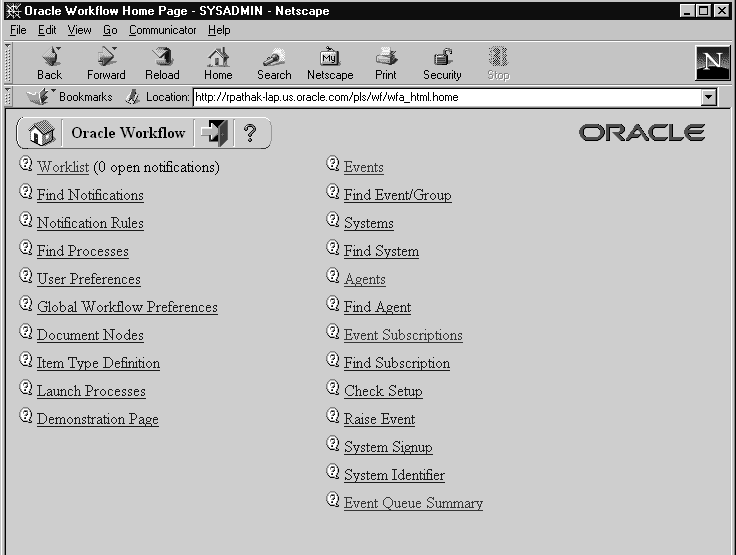
At runtime, OracleAS InterConnect integrates with the Business Event System of Oracle Workflow. The Business Event System is an application service that uses the Advanced Queueing infrastructure to communicate business events between systems. OracleAS InterConnect registers itself as an external system in Business Event System so the following conditions exist:
At runtime, Oracle Workflow is integrated with OracleAS InterConnect at the hub. Messages are passed back and forth between OracleAS InterConnect and the Business Event System of Oracle Workflow via Advanced Queues. The OracleAS InterConnect Oracle Workflow Communication Infrastructure facilitates this communication.
At design time, to keep the integration methodology consistent, iStudio reuses the messaging paradigms of publish/subscribe and request/reply to specify communication between OracleAS InterConnect and Oracle Workflow. Therefore, for messages inbound into Oracle Workflow, the iStudio user can specify, in the context of a business process, which events Oracle Workflow is subscribing to and which procedures Oracle Workflow is implementing. For outbound messages, events that Oracle Workflow can publish and procedures it can invoke can be specified.
This section describes using OracleAS InterConnect with Oracle Workflow. There are three broad steps:
You need to install the necessary Oracle Workflow components and perform required configuration tasks following the procedures described in Oracle Application Server InterConnect Installation Guide.
To deploy the business process:
.wft file.
.wft file.
To deploy business processes for runtime:
The following concepts discuss how iStudio and Oracle Workflow work together in OracleAS InterConnect. In addition, these topics discuss how to use iStudio and Oracle Workflow step by step during design time for business process collaborations across applications.
A process bundle is a set of logically related business processes. This maps one-to-one with an Oracle Workflow item.
A business process is a set of OracleAS InterConnect common view events or procedures that must be routed to and from Oracle Workflow in one Oracle Workflow business process. These events and procedures manifest themselves as Oracle Workflow business events and can be used to define a process diagram in Oracle Workflow Builder. This maps one-to-one with an Oracle Workflow business process.
Activities in iStudio allow the user to define the common view events and procedures that must be a part of an Oracle Workflow business process. The following are types of activities in iStudio:
The following table describes how iStudio and Oracle Workflow concepts are mapped.
| iStudio Concept | Oracle Workflow Concept | Mapping |
|---|---|---|
|
Process Bundle |
Item |
One-to-one. |
|
Business Process |
Business Process |
One-to-one. |
|
Common View Event |
Business Event |
One-to-one.Foot 1 |
|
Common View Procedure |
Business Event |
Two business events per procedure. |
|
Publish Activity |
Send Event Activity |
One-to-one. |
|
Subscribe Activity |
Receive Event Activity |
One-to-one. |
|
Invoke Activity |
Send Event Activity (for the request) Receive Event Activity (for the reply) |
|
|
|
||
|
Implement Activity |
Receive Event Activity (for the request) Send Event Activity (for the reply) |
|
|
|
To create a process bundle using iStudio:
To create a business process:
To populate a business process with activities:
The Subscribe Activity Wizard displays.
Repeat these steps for adding other activities to the process.
After populating business processes with activities, this information must be deployed to Oracle Workflow to graphically model a business process. To deploy this information to Oracle Workflow:
The Deploy dialog displays:
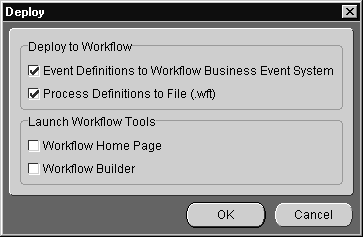
To check if events have been deployed, launch the Oracle Workflow Home page.
|
See Also:
"Launching the Oracle Workflow Home Page" for more information on the Oracle Workflow Home page. |
.wft file generation--Information about business processes captured in iStudio provides a foundation for building process diagrams in Oracle Workflow Builder. Deploying process definitions is required for design time.
By default, both choices are selected. The dialog also allows the following to be automatically launched:
By default, these choices are unselected. Choose to launch these tools with deployment or complete this task at a later time on the Design tab.
If deploying event definitions to the Oracle Workflow Business Event System is selected, the following dialog displays:
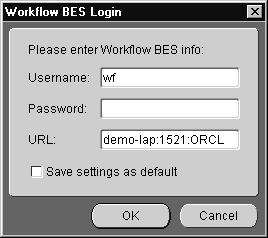
If Deploying Process Definitions to a .wft file was selected, a file dialog displays:
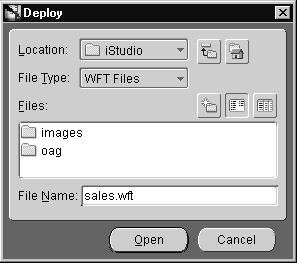
The following topics discuss how to launch Oracle Workflow tools in iStudio.
To launch the Oracle Workflow Home page:
The Username and Password Required dialog displays:
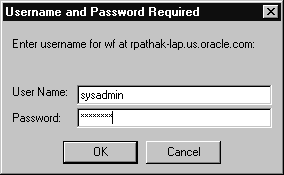
The Oracle Workflow Home page is launched using the default browser.
To launch Oracle Workflow Builder:
.wft file name to load into Oracle Workflow Builder.
Oracle Workflow Builder is launched depending on which process definition file is selected.
|
Note: To launch Oracle Workflow Builder outside of a specific OracleAS InterConnect process bundle, right-click on Workflow and select Launch Workflow Builder. |
When modifying existing Oracle Workflow processes, do not add, modify, or remove OracleAS InterConnect event activities directly in Oracle Workflow Builder. Always make all event-related process changes in iStudio, redeploy to the file, and import in Oracle Workflow Builder.
For example, the following steps were completed to create an integration-related Oracle Workflow business process:
my_process_bundle.wft file.
my_process_bundle.wft.
At this point, you need to make some event-related modifications to the business process. For example, add two new events to the business process with the following steps:
changes_to_my_process_bundle.wft. Do not deploy to my_process_bundle.wft because any non-event-related modifications made through Oracle Workflow Builder will be lost.
my_process_bundle.wft and changes_to_my_process_bundle.wft.
changes_to_my_process_bundle.wft to the process representing my_process_bundle.wft.
my_process_bundle.wft.
The my_process_bundle.wft file now contains the updated process definition with both the event and the non-event modifications.
1
This example is used for explaining the steps. The steps are similar regardless of the selection.
|
|
 Copyright © 2002, 2003 Oracle Corporation. All Rights Reserved. |
|